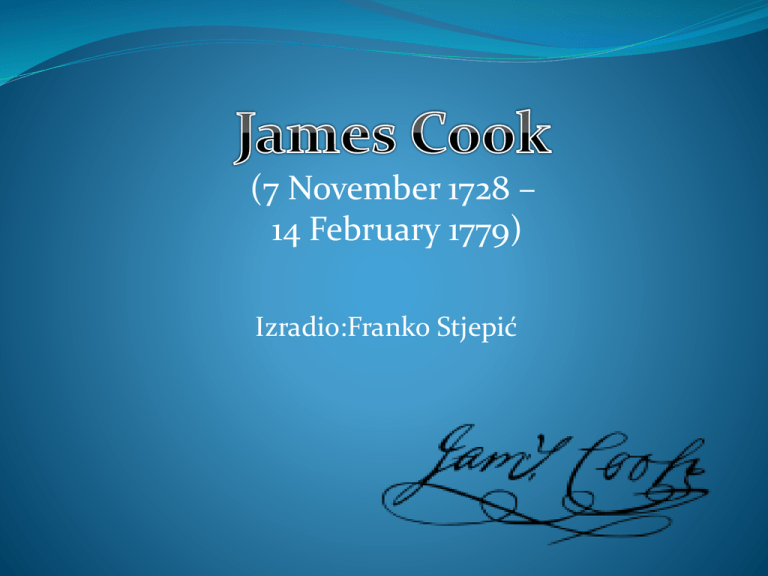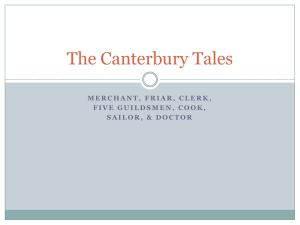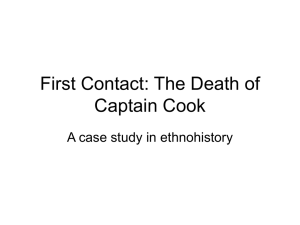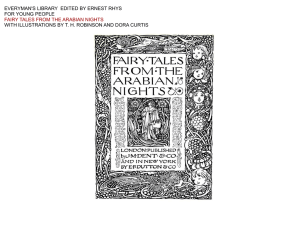James Cook
advertisement

(7 November 1728 – 14 February 1779) Izradio:Franko Stjepić About James Cook... Captain James Cook was a British explorer, navigator and cartographer He ultimately rose to the rank of captain in the Royal Navy Cook made detailed maps of Newfoundland prior to making three voyages to the Pacific Ocean ... During the journey he achieved the first European contact with the eastern coastline of Australia and the Hawaiian Islands Also he was the first who recorded the circumnavigation of New Zealand Early life Cook was born in the village of Marton in Yorkshire He was baptised in the local church of St. Cuthbert His name can be seen in the church register He was the second of eight children Education In 1736, his family moved to Airey Holme farm at Great Ayton He met his father´s employer, Thomas Skottowe Thomas Skottowe paid for him to attend the local school First job He attended school for five years After the five years in 1741 he began to work for his father His father was promoted to farm manager He didn´t seem to like the job Family Cook married Elizabeth Batts (1742–1835), the daughter of Samuel Batts, keeper of the Bell Inn The wedding was on 21 December 1762 at St. Margaret's Church in Barking, Essex The couple had six children: James (1763–94), Nathaniel (1764–81), Elizabeth (1767–71), Joseph (1768–68), George (1772–72) and Hugh (1776–93) Cook has no direct descendants—all his children either predeceased him or died without having children of their own The scent of the sea In 1745, when he was 16, Cook moved 20 miles (32 km) to the fishing village of Staithes He apprenticed as a shop boy to grocer and haberdasher William Sanderson Some say that this is where Cook first felt the lure of the sea while gazing out of the shop window ... After 18 months, not proving suitable for shop work, Cook travelled to the nearby port town of Whitby He was introduced to friends of Sanderson's, John and Henry Walker Cook was taken on as a merchant navy apprentice in their small fleet of vessels , plying coal along the English coast. The begining His first assignment was aboard the collier Freelove, and he spent several years on this and various other coaster He sailed between the Tyne and London As part of his apprenticeship, Cook applied himself to the study of algebra, geometry, trigonometry, navigation and astronomy All these skills he would need one day to command his own ship. Early career start His three-year apprenticeship completed, Cook began working on trading ships in the Baltic Sea After passing his examinations in 1752, he soon progressed through the merchant navy ranks Starting with his promotion in that year to mate aboard the collier brig Friendship Royal Navy In 1755, within a month of being offered command of this vessel, he volunteered for service in the Royal Navy Despite the need to start back at the bottom of the naval hierarchy Cook realised his career would advance more quickly in military service and entered the Navy at Wapping on 7 June 1755 ... Cook's first posting was with HMS Eagle, sailing with the rank of master's mate In October and November 1755 he took part in Eagle's capture of one French warship and the sinking of another Following which he was promoted to boatswain in addition to his other duties ... In June 1757 Cook passed his master's examinations at Trinity House, Deptford This qualified him to navigate and handle a ship of the King's fleet He then joined the frigate HMS Solebay as master under Captain Robert Craig Seven Year´s War During the Seven Years' War, he served in North America as master of Pembroke In 1758, he took part in the major amphibious assault that captured the Fortress of Louisbourg from the French after this he participated in the siege of Quebec City and then the Battle of the Plains of Abraham in 1759 Cook´s real profession Cook showed a talent for surveying and cartography He was responsible for mapping much of the entrance to the Saint Lawrence River during the siege This allowed General Wolfe to make his famous stealth attack on the Plains of Abraham Cook's aptitude for surveying was put to good use mapping the jagged coast of Newfoundland in the 1760s ... His five seasons in Newfoundland produced the first large- scale and accurate maps of the island's coasts They also gave Cook his mastery of practical surveying, achieved under often adverse conditions Cook got the attention of the Admiralty and Royal Society at a crucial moment both in his career and in the direction of British overseas discovery The first voyage (1768-71) In 1766, the Royal Society engaged Cook to travel to the Pacific Ocean to observe and record the transit of Venus across the Sun At the age of 39, he was promoted to lieutenant and named as commander of the expedition The expedition sailed from England in 1768, rounded Cape Horn and continued westward across the Pacific to arrive at Tahiti on 13 April 1769 ... However, the result of the observations was not as conclusive or accurate as had been hoped Once the observations were completed, Cook opened the sealed orders which were additional instructions from the Admiralty For the second part of the voyage he had to search the south Pacific for signs of the postulated rich southern continent TerraAustralis (a mythical large continent) ... On 23 April he made his first recorded direct observation of indigenous Australians at Brush Island near Bawley Point On 29 April Cook and crew made their first landfall on the mainland of the continent at a place now known as the Kurnell Peninsula he named Botany Bay after the unique specimens retrieved by the botanists Joseph Banks and Daniel Solander ... It is here that James Cook made first contact with an Aboriginal tribe known as the Gweagal After his departure he continued northwards The voyage was delayed almost 7 weeks because of the damage that one of the ships got by ranning aground on a shoal of the Great Barrirer Reef End of the first voyage Once repairs were complete the voyage continued, sailing through Torres Strait On 22 August he landed on Possession Island, where he claimed the entire coastline he had just explored as British territory He returned to England via Batavia (Indonesia- where many in his crew succumbed to malaria) the Cape of Good Hope and the island of Saint Helena, arriving on 12 July 1771 The second voyage (1772-75) Shortly after his return from the first voyage, Cook was promoted in August 1771, to the rank of commander In 1772 he was commissioned to search for the hypothetical Terra Australis On his first voyage he proved by circumnavigating that New Zealand wasn´t attached to a larger landmass ... Cook commanded HMS Resolution on this voyage Cook's expedition circumnavigated the globe at a very high southern latitude Becoming one of the first to cross the Antarctic Circle on 17 January 1773 ... On this leg of the voyage he brought with him a young Tahitian named Omai proved to be somewhat less knowledgeable about the Pacific than Tupaia had been on the first voyage End of the second voyage He then resumed his southward course in a second fruitless attempt to find the supposed continent On his return voyage, in 1774 he landed at the Friendly Islands, Easter Island, Norfolk Island, New Caledonia, and Vanuatu Upon his return, Cook was promoted to the rank of captain and given an honorary retirement from the Royal Navy, but they couldn´t keep him away from the sea The third voyage (1776-79) On his last voyage, Cook once again commanded HMS Resolution The voyage was planned to return Omai to Tahiti But this is what the general public believed, as he had become a favourite curiosity in London Principally the purpose of the voyage was an attempt to discover the famed Northwest Passage ... After returning Omai, Cook travelled north and in 1778 became the first European to visit the Hawaiian Islands In January 1778 passing and after initial landfall at Waimea harbour, Kauai, Cook named the archipelago the "Sandwich Islands" after the fourth Earl of Sandwich – the acting First Lord of the Admiralty ... He unknowingly sailed past the Strait of Juan de Fuca, and soon after entered Nootka Sound on Vancouver Island He anchored near the First Nations village of Yuquot There they spent about a month and discovered a Nuu-chahnulth village They traded their metal for their goods ... After leaving, Cook explored and mapped the coast all the way to the Bering Strait, on the way identifying what came to be known as Cook Inlet in Alaska The Bering Strait proved to be impassable, although he made several attempts to sail through it Cook returned to Hawaii in 1779. After sailing around the archipelago for some eight weeks, he made landfall at Kealakekua Bay ... Cook's arrival coincided with the Makahiki, a Hawaiian harvest festival of worship for the Polynesian god Lono Coincidentally the form of Cook's sails and rigging, resembled certain significant artefacts that formed part of the season of worship Similarly, Cook's clockwise route around the island of Hawaii before making landfall led to the missundertand that Cook is an incarnation of Lono Cook´s death After a month's stay, Cook got under sail again to resume his exploration of the Northern Pacific However the ships foremast broke so they needed to return This was unpleasent and the people didn´t welcome them Some tribesmen stole Cook´s small boat and some other things Cook wanted to get it all back, so he intended to take the Hawaiian King as a hostage The Hawaiian prevented it ... As Cook and his men wnet back to the ship Hawaiians attacked them They killed two of Cook´s men and stabed Cook to death Legacy Several islands such as Sandwich Islands (Hawaii) were encountered for the first time by Europeans His more accurate navigational charting of large areas of the Pacific was a major achievement Cook succeeded in circumnavigating the world on his first voyage without losing a single man He discovered many thing and helped the greater acomplishment of science








